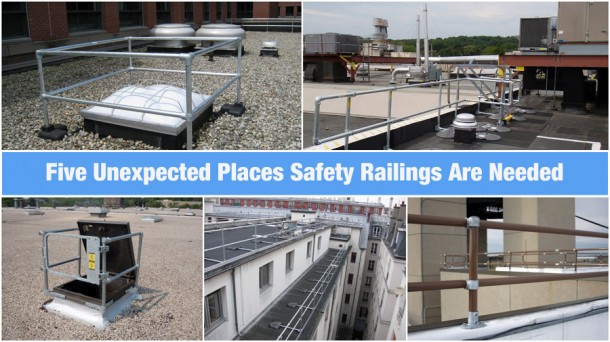Five Unexpected Places Safety Railings Are Needed

Sometimes it's obvious: you're about to work on a scaffold, at the edge of a roof, or on a piece of equipment fifteen feet high and you know instinctively that guard rails are needed.
Other times, it's not so simple. Not because safety railing wouldn't be an intuitive solution, but because you may not stop to realize that a solution – any solution - is even needed. The following are five examples of places where this might occur.
Roof Hatches
Roof hatches are safe because when nobody is climbing through them, they are always closed, right? Obviously, this is not true. It's pretty safe to say that roof hatches are often left open to allow access back into the building while people are working on the roof. This creates a dangerous fall hazard. Anybody not paying attention to where they are walking, whose view is obstructed, or who simply misjudges their step is capable of falling into the hatch. Roof hatch safety rails help mitigate this hazard.
Yes, it's possible to institute a policy that requires employees to close hatches while they are on the roof (IF the hatch could be opened from the outside), but even if it was possible to get workers to comply with this requirement 100% of the time, there could still be exposure when leaving the work area. If a group of workers leaves at the same time, they will most likely gather around the hatch as they wait for co-workers to descend, thereby rendering the closed-hatch policy useless.
Another reason rails are a good solution in this situation is that they provide a handhold (remember, a ladder must extend three feet above the level you are climbing to, or there must be a handhold equally high). When ascending or descending through the hatch, the workers could use a properly installed rail to provide them balance and security. In addition, a rail around the hatch helps to prevent workers from accessing the hatch improperly. Rails on the sides, for example, could prevent workers from stepping across the opening to get to the ladder.
Skylights
Skylights are even trickier because there is no visible opening to alert somebody to the fall hazard to which they are exposing themselves. Skylights give a false sense of security. Workers don't usually have any concept of the weight capacity of the skylight dome. Sometimes, building owners have enough sense to protect their skylights with screens, but often that costs too much, would ruin the aesthetics of the building, or is just deemed unnecessary. The idea that maintenance personnel or contractors might need to perform work on the roof often doesn't come into consideration. Whether it is during maintenance or during construction, skylights need to be protected. Permanent skylight guardrails can be installed to prevent the maintenance team from having to lug fall protection equipment to the roof every time they have to work up there (or, let's face it, just plain go without fall protection, which is more likely) or temporary rails can be erected around the skylights during construction. Either way, workers need to understand that the skylight dome does not provide fall protection.
Roof to Roof Drops
I mentioned earlier that rails are often thought of for roof edges, but when we think of roof edges, we tend to think about the building's perimeter. What about other parts of the roof that also create fall hazards? Many roofs aren't a single elevation from north to south, east to west. When you have a change in elevation, it is important to note what the change in elevation is. If it is greater than 6' for construction work or 4' for maintenance, short of having a parapet 39" or higher, you will need some form of fall protection. From the moment your employees step off that ladder onto the higher roof, they are exposed to a fall hazard.
Next to Wall Mounted Ladders
Speaking of ladders, whether from one roof elevation to another or from roof to ground, most wall-mounted ladders tend to be near the edge of the roof. Accessing these ladders exposes workers to a fall hazard. Whether workers are waiting at the top while somebody else descends or whether they are walking to the ladder themselves, their exposure to the edge is no different than that of somebody working up there. At the very least, rails should be erected on each side of the ladder to ensure that access is safe.
Parapets
Parapets could provide you with all the fall protection you need – if they're high enough. Some parapets are obviously too low to be considered compliant fall protection, while others might be close enough to fool you. Remember, unless they're a minimum of 39" high, they are not acceptable as fall protection. If your parapet is over 21", then you need to mount rails to it or place a complete rail system inside of it to achieve the necessary height. If it's not 21" high, you'll need to ensure that not only is your rail 39" or higher, but that you also have a mid-rail in place.
The biggest takeaway here is that the requirements are no different for any of these locations as they would be in any other situation. Safety rails are safety rails. They need to be just as strong in these places as they would be anywhere else. They need to be just as high. It's just that they may be needed in more places than you are thinking. Take the time to evaluate your work area, communicate your requirements and enforce your policies. It only takes one second of complacency, one moment of clumsiness, one dizzy spell, to change the lives of your employees forever.
_thumb.jpg)

_thumb.jpg)
_thumb.jpg)
_thumb.JPG)